Best Snapdragon X Elite Laptops
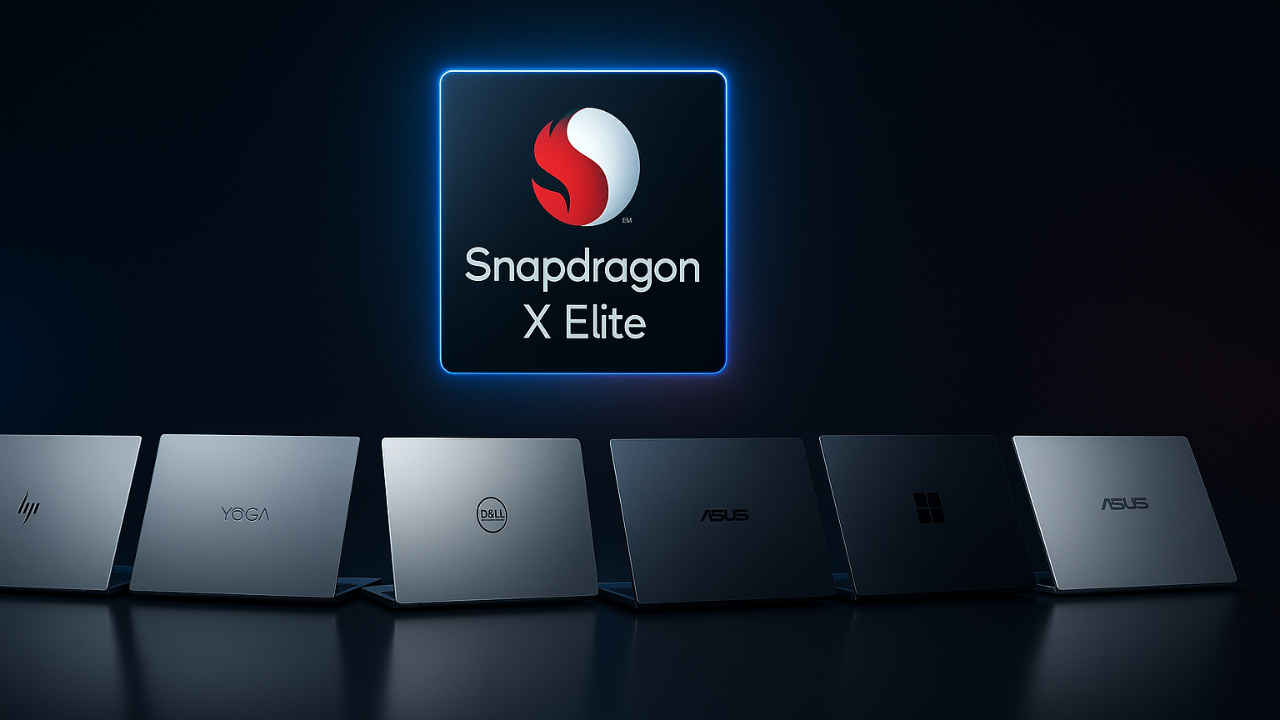
If you’re shopping for a high-performance laptop powered by Qualcomm’s Snapdragon X Elite chip, this guide has you covered. Snapdragon X Elite devices are the new class of Windows on ARM laptops offering long battery life and instant-on performance. We look at six top models available in India, highlighting what each does best. The lineup ranges from ultraportable 13-inch machines to larger 15-inch workhorses, all running Windows 11 with on-device AI acceleration.
 Survey
SurveyHP OmniBook X (₹139,999)
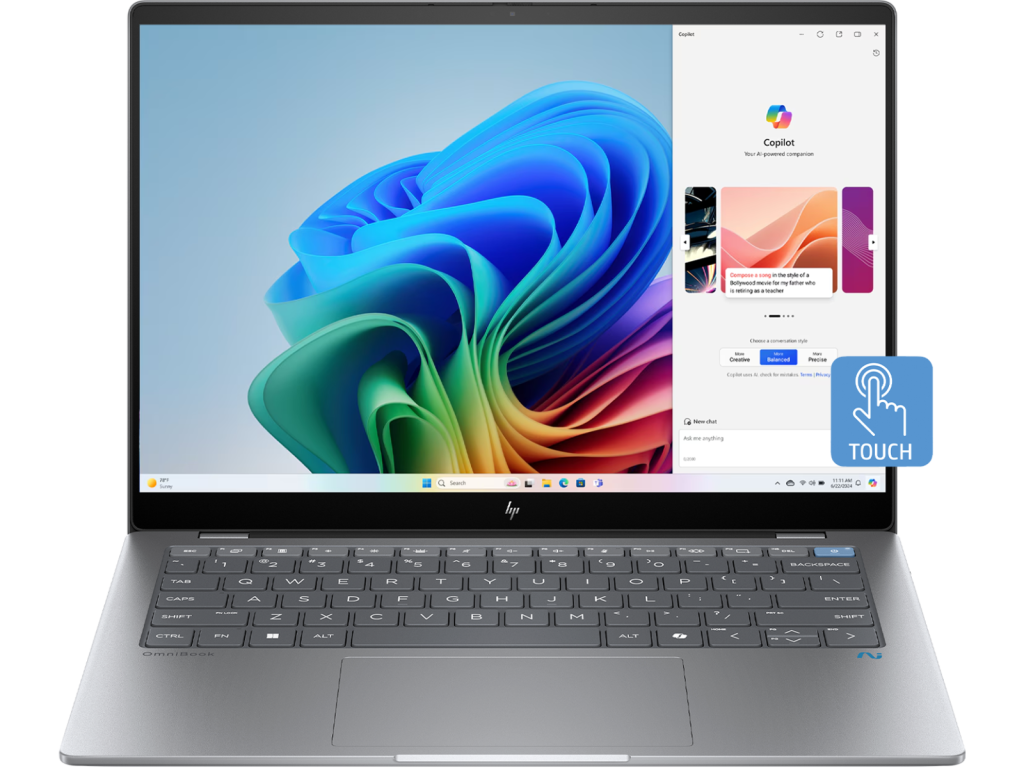
| Specification | Detail |
|---|---|
| Processor | Snapdragon® X Elite X1E-78-100 (12‑core, up to 3.4 GHz) |
| Graphics | Qualcomm® Adreno™ (integrated in X Elite) |
| Memory | 16 GB LPDDR5x (onboard) |
| Storage | 1 TB PCIe® Gen4 NVMe™ SSD |
| Display | 14.0″ (35.56 cm) 2.2K (2240×1400) IPS touch (16:10) |
| Other features | Full-size backlit keyboard, 5 MP IR camera, 26h video playback |
| Ports | 2× USB4/Thunderbolt 4 (DP/PD), 1× USB3 Type-A, 1× 3.5 mm combo jack |
| Battery | 2-cell, up to ~26 h video playback (65 Wh) |
| Weight | ~1.35 kg |
Also read: Should you buy an AI laptop in 2025?
The HP OmniBook X is a premium 14-inch AI PC built in a sandblasted aluminium chassis. It uses the Snapdragon X Elite X1E-78-100 processor (12‑core, up to 3.4 GHz) paired with 16 GB LPDDR5x RAM, giving it smooth performance for everyday work and media. Its 14.0-inch touchscreen is a 2.2K (2240×1400) IPS panel, providing clear detail and 100% sRGB coverage. One standout trait is its battery life: HP claims up to 26 hours of video playback, and in practice this laptop can easily last a full workday. The OmniBook X also includes built-in Copilot+ functionality, a 5 MP IR webcam for video calls, and fast USB4 (Thunderbolt 4) ports for charging and displays. Despite all this, it weighs only about 1.35 kg, making it very portable. In short, this model’s unique strength is combining a crisp 2.2K touchscreen and very long battery life in a slim aluminium design.
Lenovo Yoga Slim 7x Gen 9 (₹122,101)
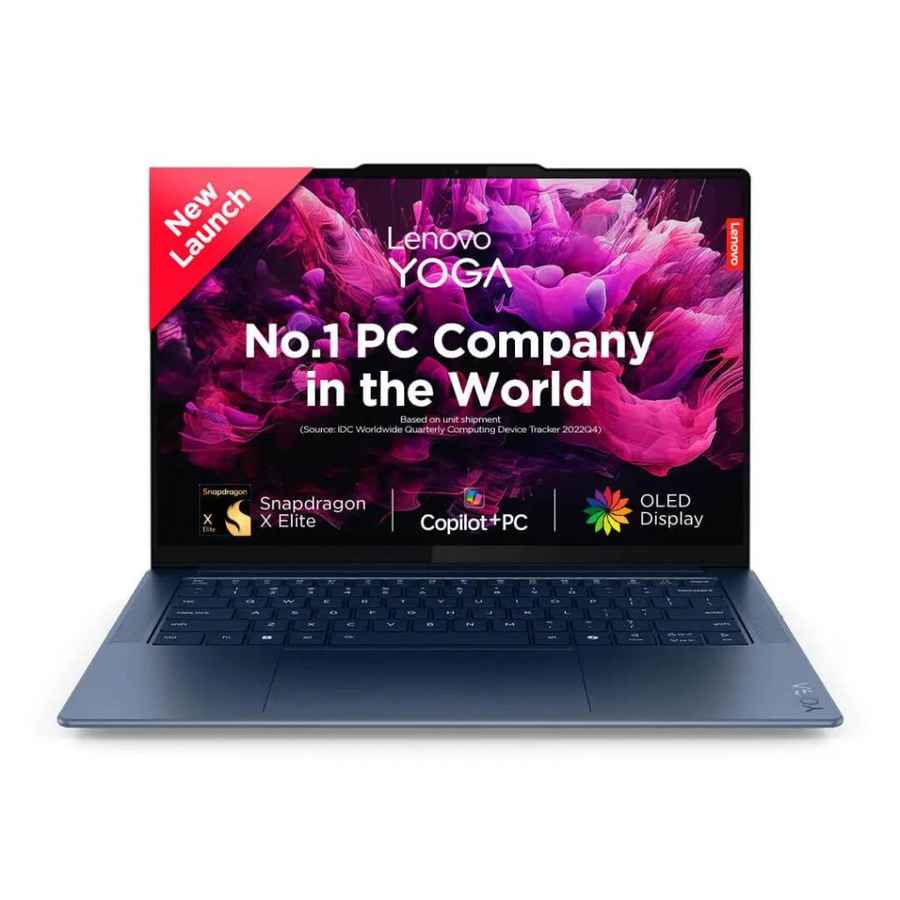
| Specification | Detail |
|---|---|
| Processor | Snapdragon® X Elite X1E-78-100 (12‑core, up to 3.4 GHz) |
| Graphics | Qualcomm® Adreno™ GPU (integrated) |
| Memory | 16 GB LPDDR5x (onboard) |
| Storage | 512 GB PCIe® Gen4 NVMe™ SSD |
| Display | 14.5″ 3K (2944×1840) PureSight OLED, 90 Hz |
| Other features | Dolby Atmos stereo speakers, IR camera with privacy shutter |
| Battery | Removable 63 Wh (up to ~20+ h video playback, 80% charge in ~30 min) |
| Wireless | Wi-Fi 7 (802.11be), Bluetooth 5.4 |
| Weight | ~1.28 kg |
The Lenovo Yoga Slim 7x Gen 9 is a sleek 14.5-inch ultrabook aimed at creators. It also uses the Snapdragon X Elite X1E-78-100 chip and 16 GB RAM, so its raw performance is on par with the HP. Where it stands out is its display: a 14.5″ 3K (2944×1840) OLED PureSight panel at 90 Hz. This screen gets extremely bright (up to 1000 nits HDR) and covers wide color gamuts, making it great for video or photo editing. The laptop is very thin (just 12.9 mm) and light (around 1.28 kg), yet it offers 3 USB-C/Thunderbolt ports and Wi-Fi 7. Its metal chassis is sturdy and it even earned military spec durability. In short, the Yoga Slim 7x is unique for packing a professional-class OLED 90 Hz display and solid portability. Battery life is also very good (reliable all-day use), and Lenovo’s AI-enhanced system features (like a smart privacy shutter) add polish.
Dell XPS 13 (₹161,028)

| Specification | Detail |
|---|---|
| Processor | Snapdragon® X Elite X1E-80-100 (12‑core, up to 4.0 GHz) |
| Graphics | Qualcomm® Adreno™ GPU |
| Memory | 16 GB LPDDR5x (8400 MHz, dual-channel) |
| Storage | 512 GB M.2 PCIe® Gen4 NVMe™ SSD |
| Display | 13.4″ OLED (2880×1800, 3K), 60 Hz, anti-reflective |
| Other features | Dolby Vision HDR, Dolby Atmos audio, quad speakers, IR camera, fingerprint reader |
| Ports | 2× USB4/Thunderbolt 4 (DP/PD) |
| Wireless | Wi-Fi 7 (FastConnect 7800), Bluetooth 5.4 |
| Battery | 55 Wh (user–replaceable), up to ~20–22 h video playback |
| Weight | ~1.17 kg (OLED model) |
Also read: AI Laptops vs Traditional Laptops: What’s the real difference?
Dell’s XPS 13 (2024 model 9345) is the classic compact premium Ultrabook refreshed with ARM power. It offers Windows 11 Pro (recommended by Dell) and the Snapdragon X Elite X1E-80-100 (12‑core, up to 4.0 GHz). The 13.4-inch PixelSense OLED touch display runs at 3K (2880×1800) and 60 Hz, with Dolby Vision support and 100% DCI-P3 colour. In practice that means a very crisp, vibrant screen in a near-borderless InfinityEdge frame. The aluminum chassis is made by CNC machining, giving it a rigid yet premium feel. Unique advantages here are the traditional XPS features: very thin bezels, excellent build quality, and an all-day battery in a small size. It includes two USB4/Thunderbolt 4 ports (for charging and external monitors) and Wi-Fi 7 connectivity. Compared to the HP/Lenovo models, the XPS starts at around 1.17 kg (OLED model). It combines that razor-thin design with strong performance and enterprise-friendly Windows Pro.
Asus Zenbook A14 (₹124,990)
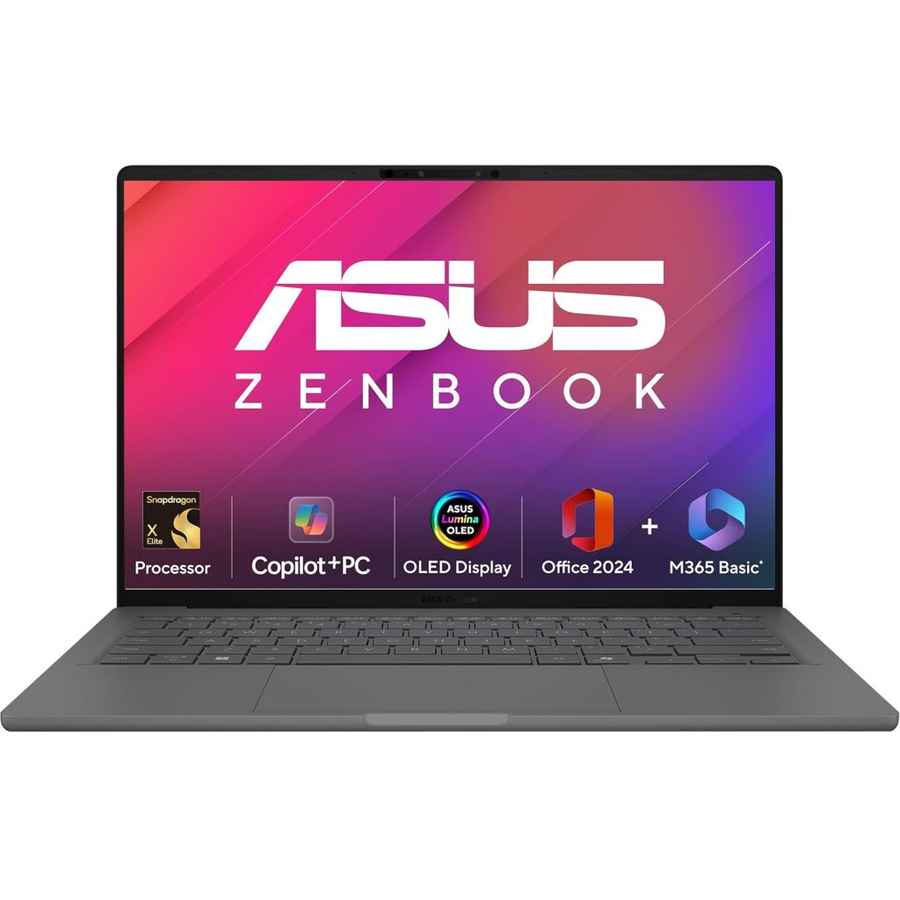
| Specification | Detail |
|---|---|
| Processor | Snapdragon® X Elite X1E-78-100 (12‑core, up to 3.4 GHz) |
| Graphics | Qualcomm® Adreno™ GPU |
| Memory | 16 GB LPDDR5x (onboard) |
| Storage | 512 GB PCIe® Gen4 NVMe™ SSD |
| Display | 14.0″ OLED (1920×1200, 60 Hz), 100% DCI-P3, 600 nits HDR |
| Other features | Gorilla Glass screen, Copilot+ key, Alexa built-in |
| Battery | 70 Wh (up to 32 h video, 65 W fast charger support) |
| Weight | ~0.98 kg |
| Wireless | Wi-Fi 6E, Bluetooth 5.2 |
The Asus Zenbook A14 balances portability with endurance. With the same Snapdragon X Elite X1E-78-100 processor and 16 GB RAM as others, its weight is under 1 kg thanks to a ceraluminium (ceramic-aluminum alloy) unibody. This laptop’s claim to fame is battery life: Asus advertises up to 32 hours of video playback on its 70 Wh battery, so it can easily go multiple workdays without charging. The 14-inch OLED display here is slightly lower resolution (WUXGA 1920×1200) than the Yoga’s, but it still offers deep blacks and high brightness (up to 600 nits HDR). Unique among this group is how lightweight and compact it is – yet it doesn’t skimp on screen quality. It also features a fast-charging USB-C port and a robust keyboard with Copilot+ key. The Zenbook A14’s standout trait is clearly its extreme portability and stamina: you get a true ultraportable chassis plus multi-day usage.
Microsoft Surface Laptop 7 (₹159,990)
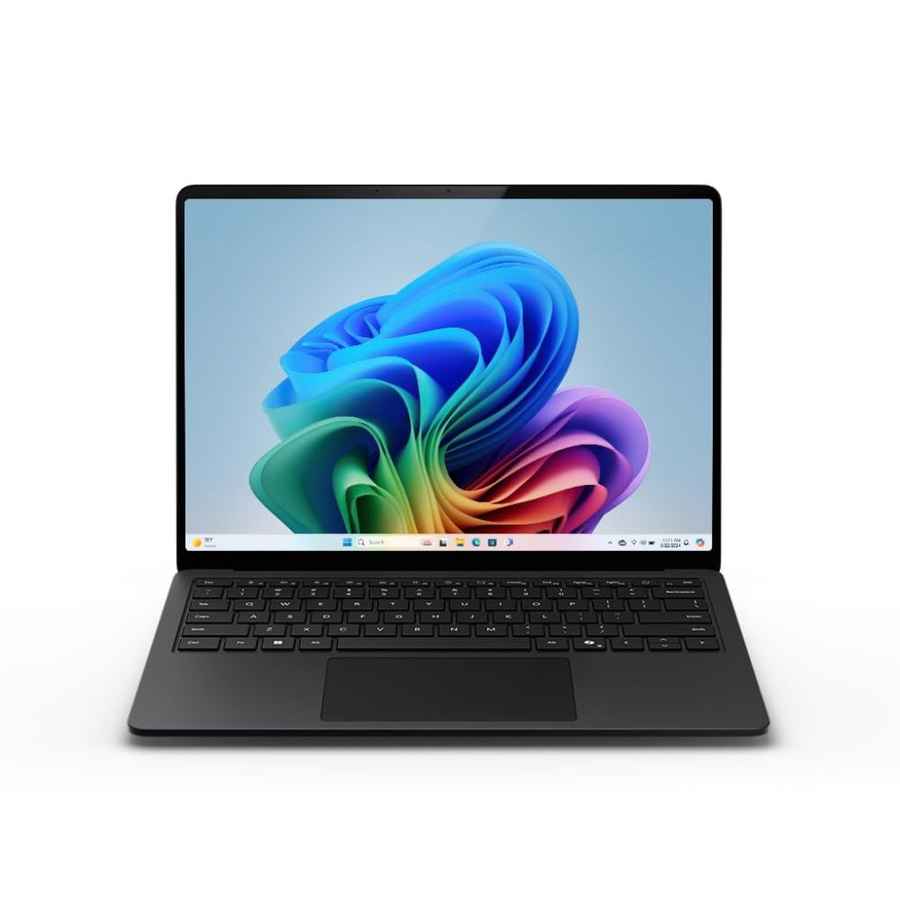
| Specification | Detail |
|---|---|
| Processor | Snapdragon® X Elite (12‑core) |
| Graphics | Qualcomm® Adreno™ GPU |
| Memory | 16 GB LPDDR5x (soldered) |
| Storage | 512 GB (UFS/PCIe Gen4) SSD |
| Display | 15.0″ PixelSense Flow (2496×1664) touch, 3:2, 120 Hz |
| Other features | Dolby Vision IQ, Gorilla Glass 5, Surface Slim Pen support |
| Battery | 66 Wh nominal (up to ~22 h video) |
| Ports | 2× USB-C/Thunderbolt 4, 1× Surface Connect |
| Wireless | Wi-Fi 7 (FastConnect 7800), Bluetooth 5.4 |
| Weight | ~1.75 kg (15″ model) |
The new Surface Laptop 7 (15″) is Microsoft’s flagship ARM-based clamshell, aimed at mainstream office and study use. It features the Snapdragon X Elite (12‑core) at its heart. Its defining feature is the 15.0″ PixelSense Flow™ touchscreen. This large display has a 3:2 aspect, 2496×1664 resolution, Gorilla Glass 5 and Dolby Vision IQ support. The result is a crisp, bright (600 nits SDR) screen great for documents and video alike. Like other Surface laptops, it has premium extras: Omnisonic stereo speakers with Dolby Atmos, an HD 1080p webcam with AI noise-canceling, and fast charging. Microsoft advertises up to 22 hours of video playback for the 15″ model, so battery life is very strong. Unique to this model is its smooth integration of Windows Copilot+ features and enterprise-grade security (Pluton TPM). For specs: the 15″ version comes with 16 GB LPDDR5x and 512 GB SSD by default (upgradable), with support for Thunderbolt 4. In short, the Surface 15″ stands out for its large, high-end touchscreen and all-round premium design as a Copilot+ PC.
Asus Vivobook S15 (₹89,990)
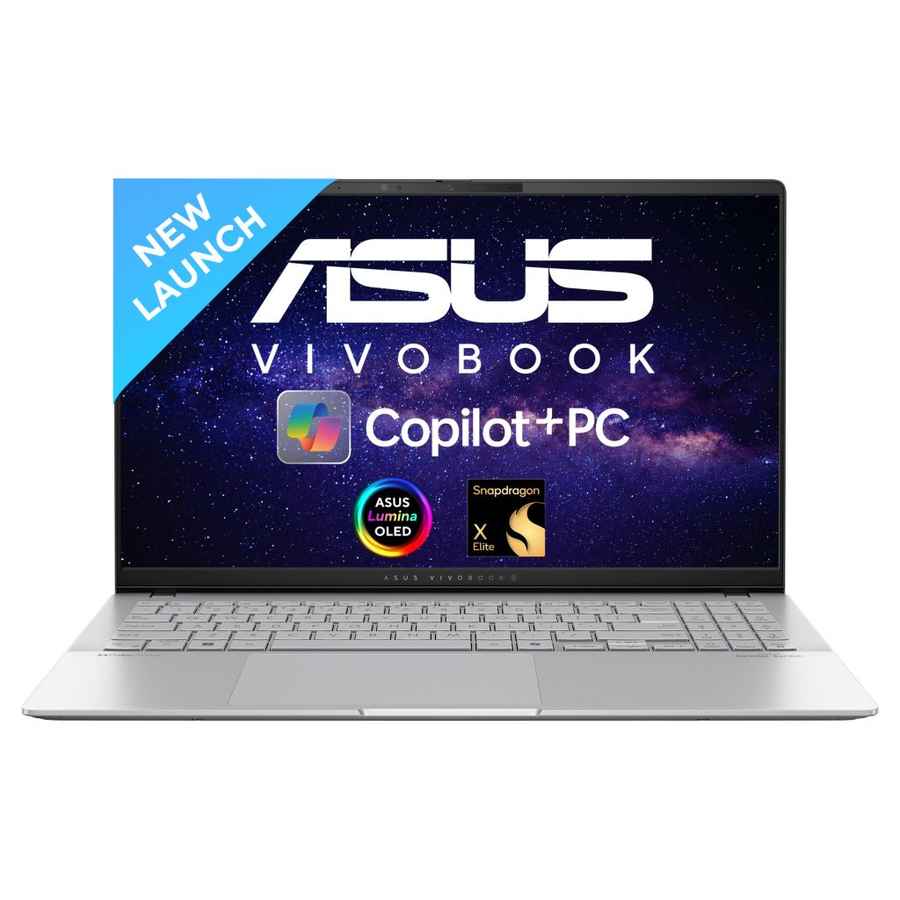
| Specification | Detail |
|---|---|
| Processor | Snapdragon® X Elite X1E-78-100 (12‑core, up to 3.4 GHz) |
| Graphics | Qualcomm® Adreno™ GPU |
| Memory | 16 GB LPDDR5x (onboard) |
| Storage | 512 GB PCIe® Gen4 NVMe™ SSD |
| Display | 15.6″ 3K OLED (2880×1620), 120 Hz, 600 nits, HDR True Black |
| Other features | MIL-STD rugged design, FHD IR camera, Spill-resistant keyboard |
| Battery | 70 Wh (up to ~15–18 h typical use) |
| Ports | 2× USB4 (PD/DP), 2× USB3.2 Type-A, HDMI 2.1, microSD slot |
| Wireless | Wi-Fi 7, Bluetooth 5.4 |
| Weight | ~1.42 kg |
The ASUS Vivobook S15 is the largest laptop in this list at 15.6 inches, and it leans towards multimedia. It runs the Snapdragon X Elite X1E-78-100 and comes with 16 GB RAM and 512 GB SSD. Its headline feature is the 15.6″ 3K (2880×1620) OLED display with a speedy 120 Hz refresh rate. This means extremely smooth scrolling and video, plus deep blacks and 1000:1 contrast. ASUS also engineered this machine to MIL-STD 810H durability standards, so it’s built tough. Other unique points include a full numeric keypad and a selection of ports: two USB4/Thunderbolt 4 ports and an HDMI 2.1 output. For audio, it has Harman/Kardon-tuned speakers. The Vivobook’s standout trait is bringing a high-refresh OLED panel to a relatively affordable class – great for gaming or high-frame-rate video. Battery capacity is 70 Wh, and it weighs about 1.42 kg.
Would you face any issues while switching to ARM?
Switching to an ARM-based Windows laptop does come with some new considerations, but for most users it’s not a deal-breaker. Windows 11 now includes full 64-bit emulation, meaning nearly any standard Windows app can run on these Snapdragon machines. In practice, common productivity software, streaming apps and even many professional tools work fine. The main caveats are niche issues: certain specialized device drivers or antivirus programs may not have native ARM support. A few users have also mentioned minor glitches in very old games or 32-bit emulators. In summary, as long as you rely on mainstream software or have Windows 11, you probably won’t notice major limitations, and you gain the benefits of instant-on resumes, very long battery life, and fanless designs. If you use highly specialised legacy Windows programs, double-check compatibility, but for general business, creative or home use, Snapdragon X Elite laptops can handle the job with few compromises.
Sagar Sharma
A software engineer who happens to love testing computers and sometimes they crash. While reviving his crashed system, you can find him reading literature, manga, or watering plants. View Full Profile